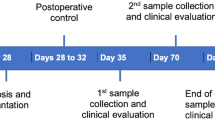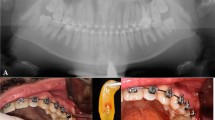Summary
When simulated immune complexes (SIC) (heat-aggregated IgG) possessing many of the properties of true antigen-antibody complexes were injected via the root canal into the periapical tissues of cat maxillary cuspids, radiographically and histologically evident bone resorption occurred at these sites within 7 days. Bone loss was accompanied in all cases by inflammation of the surrounding collagenous connective tissues and was characterized by the presence of osteoclasts. Bone resorption, but not the accumulation of inflammatory cells, was blocked by the systemic administration of indomethacin, an inhibitor of prostaglandin synthetase. The most likely explanation is that SIC-activated mechanisms such as the complement cascade, prostaglandin synthesis, and neutrophil degranulation were responsible for the bone loss. The minor inflammation and bone loss that followed the repeated injections of BSA and of monomeric IgG can best be explained as a response to trauma. The data presented establish that the cat maxillary cuspid is a useful model in which to explore the mechanism underlying pathological bone resorption.
Similar content being viewed by others
References
Gilliland, B.C., Mannick, M.: Reiter’s syndrome, psoriatic arthritis, arthritis associated with gastrointestinal diseases and Behcet’s syndrome. In G.W. Thorn, R.D. Adams, E. Braunwald, K.J. Isselbacher, R.G. Petersdorf (eds.): Harrison’s Principles of Internal Medicine, pp. 2061–2075. McGraw-Hill, New York, 1977
Harris, M., Jenkins, M.V., Bennett A., Wills, M.R.: Prostaglandin production and bone resorption by dental cysts, Nature245:213–215, 1973
Hammerman, D., Sandson, J., Schubert, M.: Biochemical events in joint disease, J. Chronic Dis.16:835–852, 1963
Kulka, J.P.: The lesions of Reiter’s syndrome, Arthritis Rheum.5:195–201, 1962
Page, R.C., Schroeder, H.E.: Pathogenesis of inflammatory periodontal disease. A summary of current work, Lab. Invest.34:235–249, 1976
Uehlinger, E.: Bone changes in rheumatoid arthritis and their pathogenesis. In W. Muller, H.-G. Harwerth, K. Fehr, (eds.): Rheumatoid Arthritis: Pathogenetic Mechanisms and Consequences in Therapeutics, pp. 25–31. Academic Press, New York, 1971
Fell, H.B., Weiss, L.: The effect of antiserum, alone and with hydrocortisone, on foetal mouse bones in cultures, J. Exp. Med.121:551–560, 1965
Fell, H.B., Coombs, R.R.A., Dingle, J.T.: The breakdown of embryonic (chick) cartilage and bone cultivated in the presence of complement-sufficient antisera. 1. Morphological changes, their reversibility and inhibition, Int. Arch. Allergy Appl. Immunol.30:146–176, 1966
Dingle, J.T., Fell, H.B., Coombs, R.R.A.: The breakdown of embryonic (chick) cartilage and bone cultivated in the presence of complement-sufficient antisera. 2. Biochemical changes and role of the lysosomal system, Int. Arch. Allergy Appl. Immunol.31:283–303, 1967
Lachmann, P.J., Coombs, R.R.A., Fell, H.B., Dingle, J.T.: The breakdown of embryonic (chick) cartilage and bone cultivated in the presence of complement-sufficient antisera. 3. Immunologic analysis, Int. Arch. Allergy Appl. Immunol.36:469–485, 1969
Fell, H.B., Barratt, M.E.J.: The role of soft connective tissue in the breakdown of pig articular cartilage cultivated in the presence of complement-sufficient antiserum to pig erythrocytes. 1. Histological changes, Int. Arch. Allergy Appl. Immunol.44:441–468, 1973
Poole, A.R., Barratt, M.E.J., Fell, H.B.: The role of soft connective tissue in the breakdown of pig articular cartilage cultivated in the presence of complement-sufficient antiserum to pig erythrocytes. 2. Distribution of immunoglobulin G (IgG), Int. Arch. Allergy Appl. Immunol.44:469–488, 1973
Raisz, L.G., Sandberg, A.L., Goodson, J.M., Simmons, H.A., Mergenhagen, S.E.: Complement-dependent stimulation of prostaglandin synthesis and bone resorption, Science185:789–791, 1973
Sandberg, A.L., Raisz, L.G., Goodson, J.M., Simmons, H.A., Mergenhagen, S.E.: Initiation of bone resorption by the classical and alternative C pathways and its mediation by prostaglandins, J. Immunol.119:1378–1381, 1977
Klein, D.C., Raisz, L.G.: Prostaglandins: stimulation of bone resorption in tissue culture, Endocrinology86:1436–1440, 1970
Christian, C.L.: Studies of aggregated gamma-globulin. I. Sedimentation, electrophoretic and anticomplementary properties, J. Immunol.84:112–116, 1960
Ishizaka, K.: Gamma-globulin and molecular mechanisms of hypersensitivity reactions, Prog. Allergy7:32–106, 1963
Theofilopoulos, A.N., Dixon, F.J., Bokisch, V.N.: Binding of soluble immune complexes to human lymphoblastoid cells. I. Characterization of receptors for IgGFc and complement and description of binding mechanism, J. Exp. Med.140:877–893, 1974
Spiegelberg, H., Weigle, W.O.: The catabolism of homologous and heterologous 7S gamma-globulin fragments, J. Exp. Med.121:323–338, 1965
Gamble, C.N.: The role of soluble aggregates in the primary immune response of mice to human gamma-globulin, Int. Arch Allergy Appl. Immunol.30:446–455, 1966
Chiller, J.M., Weigle, W.O.: Cellular events during the induction of immunologic unresponsiveness in adult mice, J. Immunol.106:1647–1653, 1971
Cerottini, J.C.: An antigen-binding capacity test for human immunoglobulin G (IgG) fragments, J. Immunol.101:433–438, 1968
Schermer, S.: The Blood Morphology of Laboratory Animals, p. 101. F.A. Davis Co., Philadelphia, 1967
Goodson, J.M., Dewhirst F., Brunetti A.: Prostaglandin-E2 levels in human gingival tissue, Prostaglandins6:81–85, 1974
Robinson, D.R., Tashjian, A.H., Levine, L.: Prostaglandin-stimulated bone resorption by rheumatoid synovia: a possible mechanism for bone destruction in rheumatoid arthritis. J. Clin. Invest.58:1181–1188 (1975)
Webb, D.R., Osheroff, P.L.: Antigen stimulation of prostaglandin synthesis and control of immune responses, Proc. Natl. Acad. Sci. U.S.A.73:1300–1304, 1976
Ferraris, V.A., DeRubertis, F.R.: Release of prostaglandin by mitogen-and antigen-stimulated leukocytes in culture, J. Clin. Invest.54:378–386, 1974
Hamprecht, B., Jaffe, B.M., Philpott, G.W.: Prostaglandin production by neuroblastoma, glioma and fibroblast cell lines; stimulation by N6, O2-dibutyryl adenosine 3′:5′-cyclic monophosphate, FEBS Lett.36:193–198, 1973
Zurier, R.B., Sayadoff, S.M.: Release of prostaglandins from human polymorphonuclear leukocytes, Inflammation1:93–101, 1975
Myatt, L., Bray, M.A., Gordon, D., Morley, J.: Macrophages on intrauterine contraceptive devices produce prostaglandins, Nature257:227–228, 1976
Sandberg, A.L., Raisz, L.G., Goodson, J.M., Wahl, L.M., Mergenhagen, S.E.: Complement dependent bone resorption. In J. Horton, T. Tarpley, W. Davis, (eds.): Proceeding, Mechanisms of Localized Bone Loss, Special Supplement to Calcified Tissue Abstracts, pp. 159–169, 1978
Muller-Eberhard, H.J.: Complement, Annu. Rev. Biochem.44:697–724, 1975
Dickler, H.B., Kunkel, H.G.: Interaction of aggregated γ-globulin with B lymphocytes, J. Exp. Med.136:191–196, 1972
Haakenstad, M.D., Mannik, M.: The Biology of Immune Complexes: Autoimmunity, pp. 277–360. Academic Press, New York, 1977
Seltzer, S., Soltanoff, W., Sinai, I., Goldenberg, A., Bender, I.: Biologic aspects of endodontics. III: Periapical tissue reactions to root canal instrumentation, Oral Surg.26:534–546, 1968
Cochrane, G.G., Koffler, D.: Immune complex disease in experimental animals and man, Adv. Immunol.16:186–264, 1973
Weissman, G.: Lysosomal mechanisms of tissue injury in arthritis, N. Engl. J. Med.286:141–147, 1972
Henson, P.M.: Pathologic mechanisms in neutrophil-mediated injury, Am. J. Pathol.68:593–612, 1972
Hawkins, D., Peeters, S.: The response of polymorphonuclear leukocytes to immune complexesin vitro, Lab. Invest.24:483–491, 1971
Hawkins, P.: Biopolymer membrane: a model system for the study of the neutrophilic leukocytes response to immune complexes, J. Immunol.107:344–352, 1971
Cooke, T.D., Hurd, E.R., Ziff, M., Jasin, H.E.: The pathogenesis of chronic inflammation in experimental antigen-induced arthritis. II. Preferential localization of Ag-Ab complexes to collagenous tissues, J. Exp. Med.135:323–331, 1972
Jasin, H.E.: Mechanism of trapping of immune complexes in joint collagenous tissues, Clin. Exp. Immunol.22:473–485, 1975
Cardella, C.J., Davies, P., Allison, A.C.: Immune complexes induce selective release of lysosomal hydrolases from macrophagesin vitro, Nature247:46–48, 1974
Author information
Authors and Affiliations
Rights and permissions
About this article
Cite this article
Torbinejad, M., Clagett, J. & Engel, D. A cat model for the evaluation of mechanisms of bone resorption: Induction of bone loss by simulated immune complexes and inhibition by indomethacin. Calcif Tissue Int 29, 207–214 (1979). https://doi.org/10.1007/BF02408082
Received:
Revised:
Accepted:
Issue Date:
DOI: https://doi.org/10.1007/BF02408082




